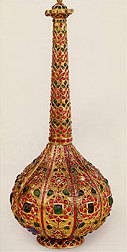07.10.2004 15:47
 One expects, in the great institutions of Russia, to encounter a Gogolian bureaucracy. I seemed to possess an Open Sesame. As long as the relevant curator could be found (something that could not, of course, be guaranteed), doors flew open.
One expects, in the great institutions of Russia, to encounter a Gogolian bureaucracy. I seemed to possess an Open Sesame. As long as the relevant curator could be found (something that could not, of course, be guaranteed), doors flew open.
The only trick was to know what to ask for. I asked to see Tiepolo drawings, but there were more than 200 Tiepolo drawings to choose from. I asked to see Byzantine coins, but was begged to be a little more specific. What a nightmare, I realised, such visitors as myself must be, to curators presiding over a million coins, when we come in asking vaguely to see something Byzantine. This could go on all week!
When one of the recent governments wanted to persecute the Hermitage director, they set up a commission to check on the inventory: there are three and a half million objects in the museum's collections, and all were to be accounted for. In one medieval department, the curator could find everything except a knife. In another, every piece of classical sculpture except one foot, which, she supposed, must have gone missing under a previous regime.
The men came to make the inventory. Why was that Greek statue now without a head? The curator had to explain that the head in the inventory did not belong to the torso, and had been removed. The inventory-maker turned his attention to a chandelier: he had to count every single crystal. But how do you do this to a chandelier? How can you remember where you began? Or how far you had got before you were interruptedIt is a nightmare, but of course in any museum it is a necessary nightmare. It had been noticed at some stage, I gather, on the Russian black market, that chandeliers were turning up, concocted out of genuine 18th-century crystal elements. Someone had been going around, somewhere, stealing a piece here, a piece there, until they had enough for a passable new chandelier.
Good inventories are of the essence. (I saw a beautiful 19th-century one in the coin department, written in French.) The great universal museums contain vast repositories of stock: thousands of objects from archaeological digs, each a piece of evidence that must be preserved for the sake of some future scholarly inquiry. That such museums have more than they can ever expect to show is not to be viewed as some guilty secret, some vice of hoarding.
We should expect archaeological evidence to be preserved by our museums, just as we expect forensic evidence to be preserved by our police departments. That's what these potsherds, these seals, these mud bricks are - forensic evidence. And we should be outraged if museums neglect their scholarly collections, just as we are outraged when the police are found to have destroyed forensic evidence.
And when we read that the Hermitage can display only 5% of its collections, while we may hope that in time it is able to show more, we should not feel that justice will only be done when 100% of the objects are on display. Please heaven not! We expect museums to show the visitor some mercy. Show us your best pots please, but don't, please don't, show us every single sacred sherd.
A museum like the Hermitage can be both rich and poor - rich in gold, rich in ivory, but poor in, say, Carolingian ivory. One should not assume that an overall impression of bounteousness implies a bounteousness evenly distributed throughout every department, every type of object. The Indian collection at the Hermitage (I was able to visit the soon-to-be-opened new galleries) is beautiful but in many respects modest. Weaker on sculpture, it is rich in Indian miniatures.
You will see, at the Hermitage Rooms in Somerset House in London, that the selection of Islamic objects from St Petersburg gives an impression of great wealth, but that many of the 133 (superb) objects on display come from the private Khalili Collection. A recent, larger Islamic exhibition at the Hermitage itself was based on the same cooperation. Clearly the director feels that the numerous works which are found scattered throughout the departments of his huge museum are not quite sufficient, on their own, to represent the huge subject of Islamic art.
Anyway, this type of cooperation is characteristic of the post-perestroika Hermitage. It seems admirable to me, since it takes eager advantage of the new situation of the museum. The London show runs till October. Prestel publish the catalogue, which is called Heaven on Earth: Art from Islamic Lands. I recommend the richly jewelled, enamelled objects which came from Mogul India to the St. Petersburg of Ivan VI, in 1741, as a gift from Nadir Shah, "as a cloak for his designs on the northern Caucasus". A single flask boasts 40 diamonds, 1,439 rubies, and 509 emeralds. You see, they have counted them. Most of the emeralds, surprisingly enough, are Columbian.
News source: www.guardian.co.uk
 Print this news Print this news
Culture news archive for 10 July' 2004.
Culture news archive for July' 2004.
Culture news archive for 2004 year.
|